2016 NISSAN PATHFINDER fuel
[x] Cancel search: fuelPage 488 of 540
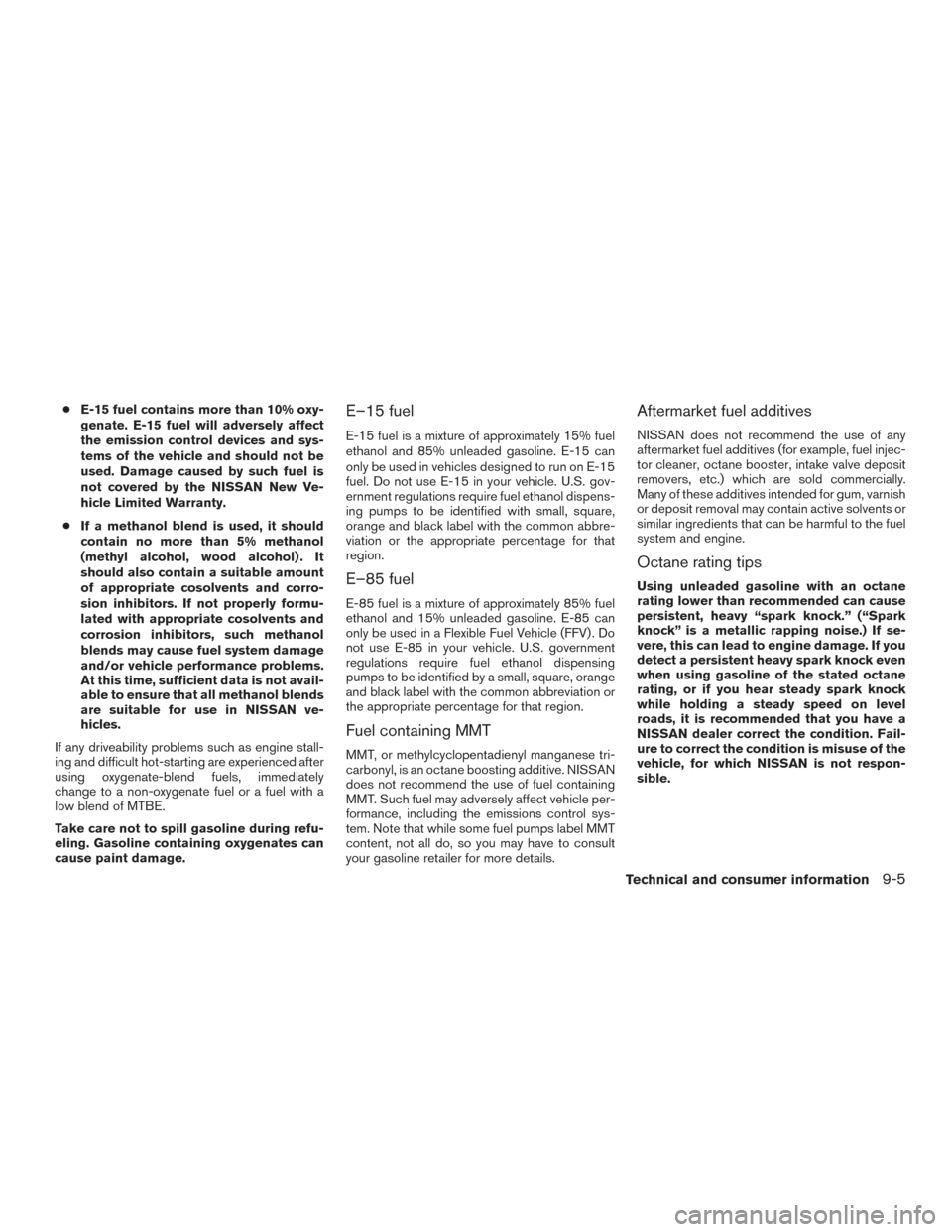
●E-15 fuel contains more than 10% oxy-
genate. E-15 fuel will adversely affect
the emission control devices and sys-
tems of the vehicle and should not be
used. Damage caused by such fuel is
not covered by the NISSAN New Ve-
hicle Limited Warranty.
● If a methanol blend is used, it should
contain no more than 5% methanol
(methyl alcohol, wood alcohol) . It
should also contain a suitable amount
of appropriate cosolvents and corro-
sion inhibitors. If not properly formu-
lated with appropriate cosolvents and
corrosion inhibitors, such methanol
blends may cause fuel system damage
and/or vehicle performance problems.
At this time, sufficient data is not avail-
able to ensure that all methanol blends
are suitable for use in NISSAN ve-
hicles.
If any driveability problems such as engine stall-
ing and difficult hot-starting are experienced after
using oxygenate-blend fuels, immediately
change to a non-oxygenate fuel or a fuel with a
low blend of MTBE.
Take care not to spill gasoline during refu-
eling. Gasoline containing oxygenates can
cause paint damage.E–15 fuel
E-15 fuel is a mixture of approximately 15% fuel
ethanol and 85% unleaded gasoline. E-15 can
only be used in vehicles designed to run on E-15
fuel. Do not use E-15 in your vehicle. U.S. gov-
ernment regulations require fuel ethanol dispens-
ing pumps to be identified with small, square,
orange and black label with the common abbre-
viation or the appropriate percentage for that
region.
E–85 fuel
E-85 fuel is a mixture of approximately 85% fuel
ethanol and 15% unleaded gasoline. E-85 can
only be used in a Flexible Fuel Vehicle (FFV) . Do
not use E-85 in your vehicle. U.S. government
regulations require fuel ethanol dispensing
pumps to be identified by a small, square, orange
and black label with the common abbreviation or
the appropriate percentage for that region.
Fuel containing MMT
MMT, or methylcyclopentadienyl manganese tri-
carbonyl, is an octane boosting additive. NISSAN
does not recommend the use of fuel containing
MMT. Such fuel may adversely affect vehicle per-
formance, including the emissions control sys-
tem. Note that while some fuel pumps label MMT
content, not all do, so you may have to consult
your gasoline retailer for more details.
Aftermarket fuel additives
NISSAN does not recommend the use of any
aftermarket fuel additives (for example, fuel injec-
tor cleaner, octane booster, intake valve deposit
removers, etc.) which are sold commercially.
Many of these additives intended for gum, varnish
or deposit removal may contain active solvents or
similar ingredients that can be harmful to the fuel
system and engine.
Octane rating tips
Using unleaded gasoline with an octane
rating lower than recommended can cause
persistent, heavy “spark knock.” (“Spark
knock” is a metallic rapping noise.) If se-
vere, this can lead to engine damage. If you
detect a persistent heavy spark knock even
when using gasoline of the stated octane
rating, or if you hear steady spark knock
while holding a steady speed on level
roads, it is recommended that you have a
NISSAN dealer correct the condition. Fail-
ure to correct the condition is misuse of the
vehicle, for which NISSAN is not respon-
sible.
Technical and consumer information9-5
Page 489 of 540
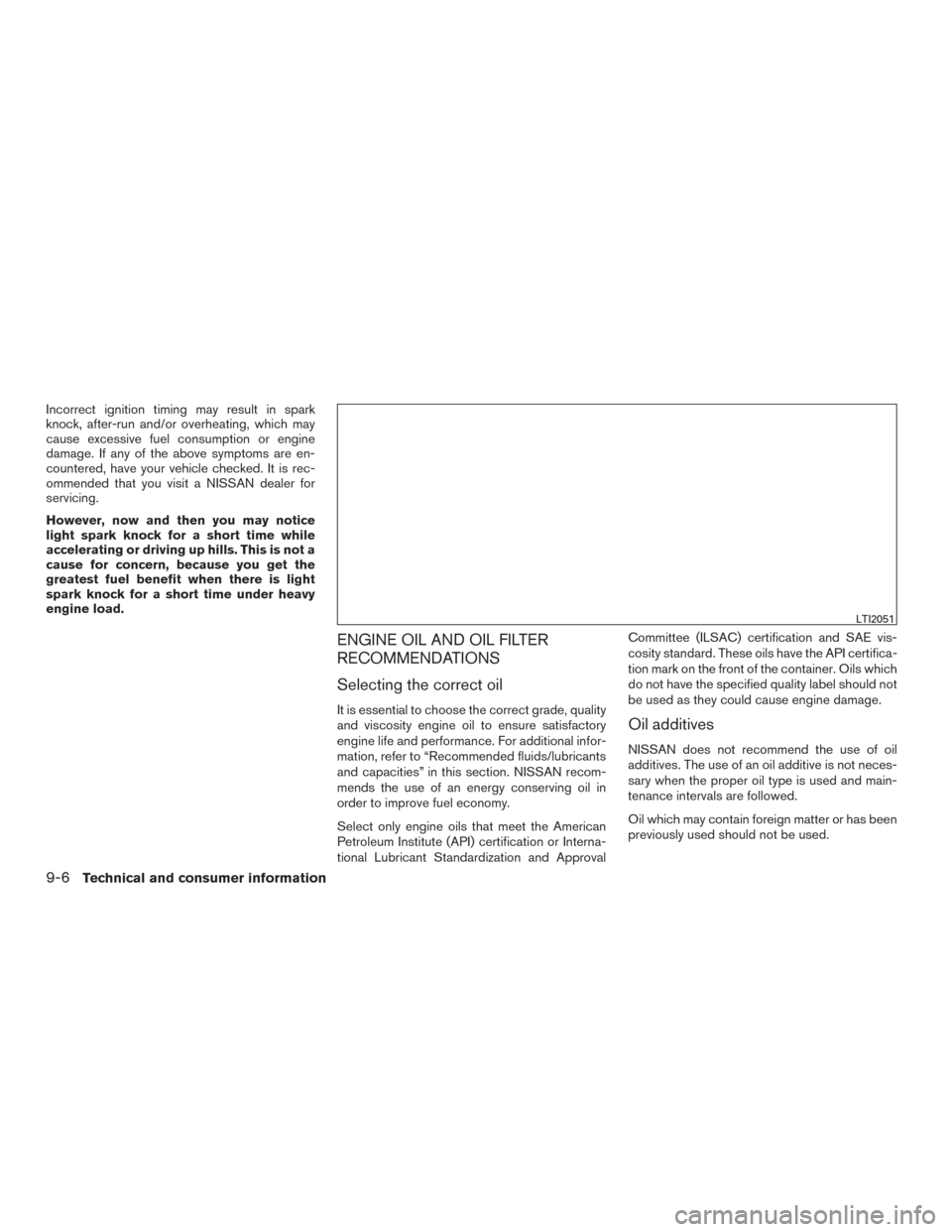
Incorrect ignition timing may result in spark
knock, after-run and/or overheating, which may
cause excessive fuel consumption or engine
damage. If any of the above symptoms are en-
countered, have your vehicle checked. It is rec-
ommended that you visit a NISSAN dealer for
servicing.
However, now and then you may notice
light spark knock for a short time while
accelerating or driving up hills. This is not a
cause for concern, because you get the
greatest fuel benefit when there is light
spark knock for a short time under heavy
engine load.
ENGINE OIL AND OIL FILTER
RECOMMENDATIONS
Selecting the correct oil
It is essential to choose the correct grade, quality
and viscosity engine oil to ensure satisfactory
engine life and performance. For additional infor-
mation, refer to “Recommended fluids/lubricants
and capacities” in this section. NISSAN recom-
mends the use of an energy conserving oil in
order to improve fuel economy.
Select only engine oils that meet the American
Petroleum Institute (API) certification or Interna-
tional Lubricant Standardization and ApprovalCommittee (ILSAC) certification and SAE vis-
cosity standard. These oils have the API certifica-
tion mark on the front of the container. Oils which
do not have the specified quality label should not
be used as they could cause engine damage.Oil additives
NISSAN does not recommend the use of oil
additives. The use of an oil additive is not neces-
sary when the proper oil type is used and main-
tenance intervals are followed.
Oil which may contain foreign matter or has been
previously used should not be used.
LTI2051
9-6Technical and consumer information
Page 493 of 540
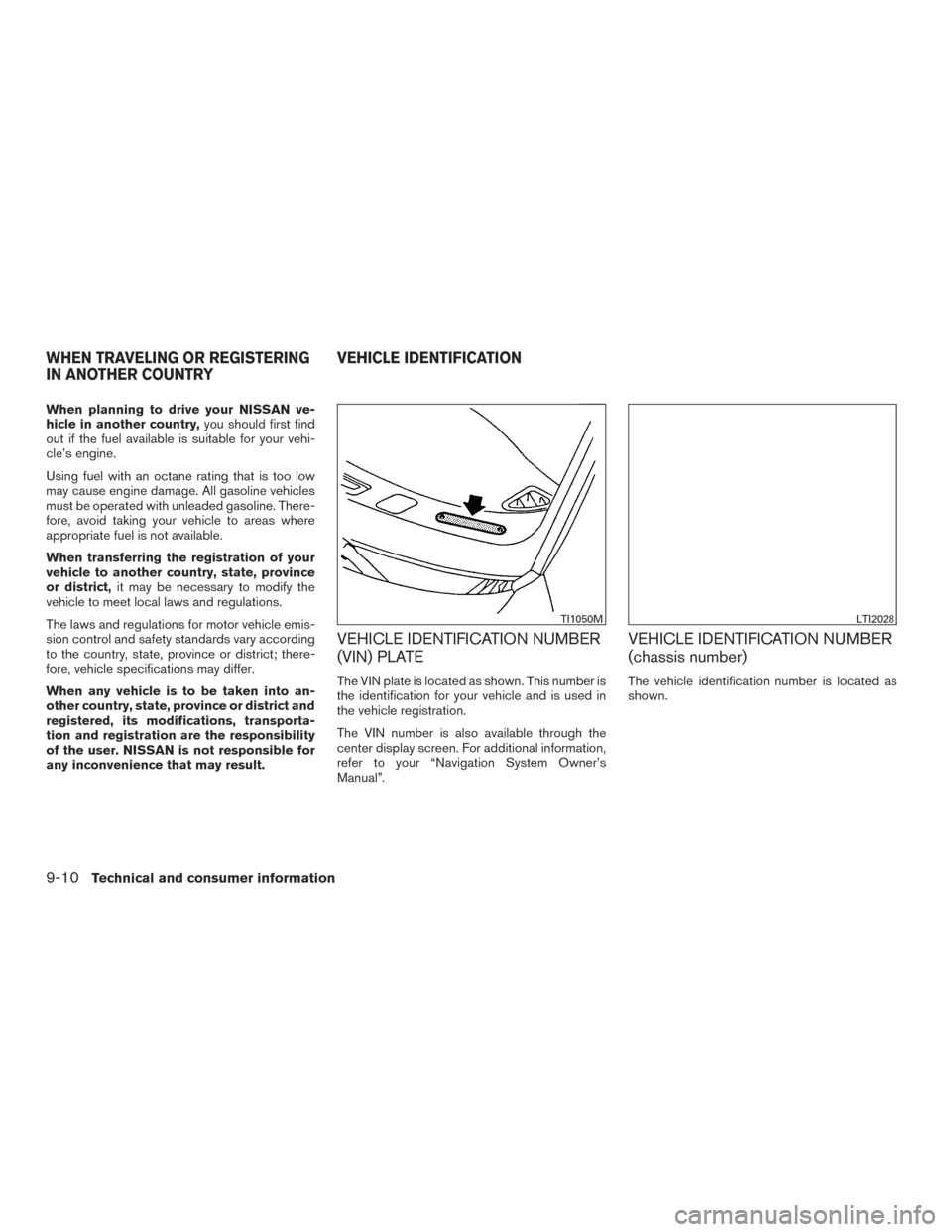
When planning to drive your NISSAN ve-
hicle in another country,you should first find
out if the fuel available is suitable for your vehi-
cle’s engine.
Using fuel with an octane rating that is too low
may cause engine damage. All gasoline vehicles
must be operated with unleaded gasoline. There-
fore, avoid taking your vehicle to areas where
appropriate fuel is not available.
When transferring the registration of your
vehicle to another country, state, province
or district, it may be necessary to modify the
vehicle to meet local laws and regulations.
The laws and regulations for motor vehicle emis-
sion control and safety standards vary according
to the country, state, province or district; there-
fore, vehicle specifications may differ.
When any vehicle is to be taken into an-
other country, state, province or district and
registered, its modifications, transporta-
tion and registration are the responsibility
of the user. NISSAN is not responsible for
any inconvenience that may result.
VEHICLE IDENTIFICATION NUMBER
(VIN) PLATE
The VIN plate is located as shown. This number is
the identification for your vehicle and is used in
the vehicle registration.
The VIN number is also available through the
center display screen. For additional information,
refer to your “Navigation System Owner’s
Manual”.
VEHICLE IDENTIFICATION NUMBER
(chassis number)
The vehicle identification number is located as
shown.
TI1050MLTI2028
WHEN TRAVELING OR REGISTERING
IN ANOTHER COUNTRY VEHICLE IDENTIFICATION
9-10Technical and consumer information
Page 509 of 540
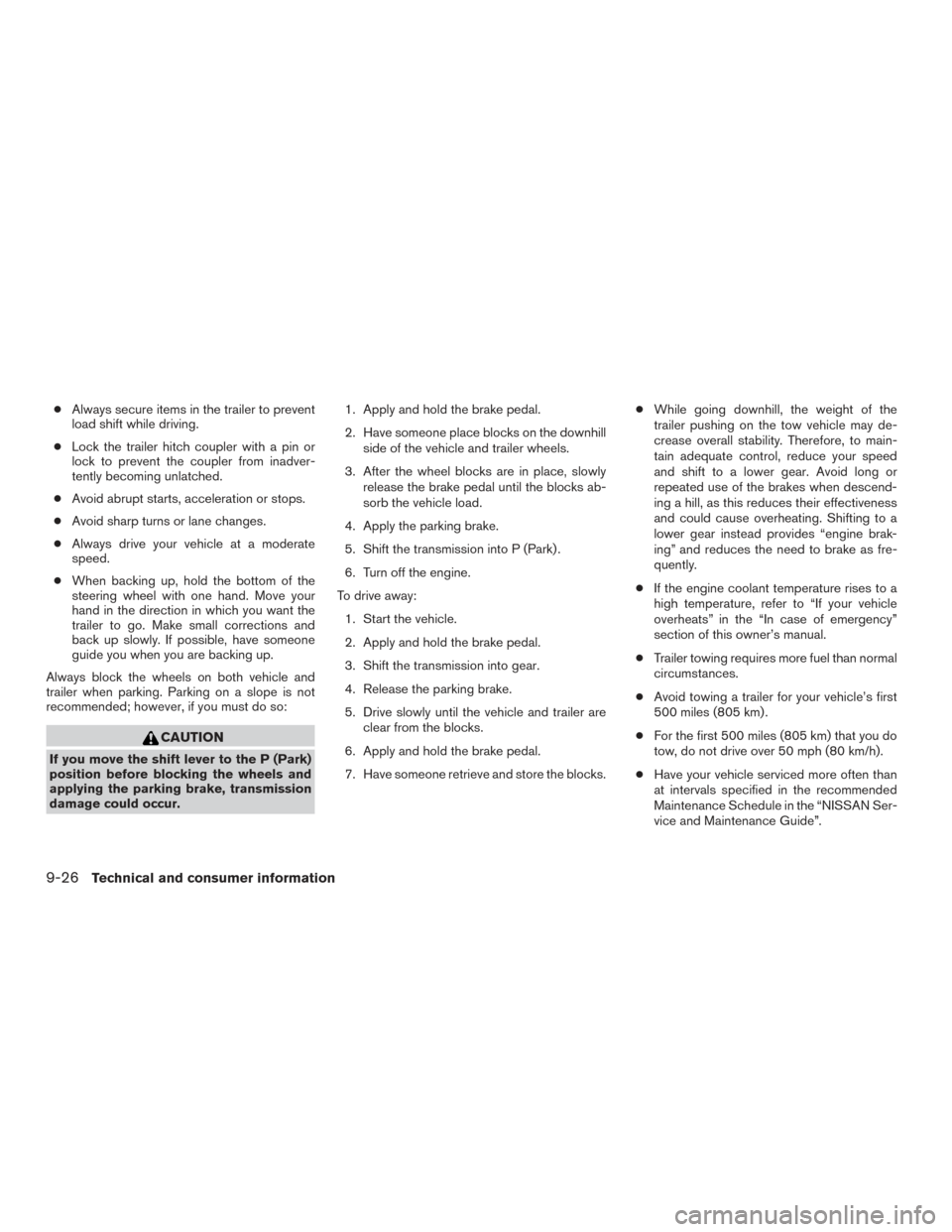
●Always secure items in the trailer to prevent
load shift while driving.
● Lock the trailer hitch coupler with a pin or
lock to prevent the coupler from inadver-
tently becoming unlatched.
● Avoid abrupt starts, acceleration or stops.
● Avoid sharp turns or lane changes.
● Always drive your vehicle at a moderate
speed.
● When backing up, hold the bottom of the
steering wheel with one hand. Move your
hand in the direction in which you want the
trailer to go. Make small corrections and
back up slowly. If possible, have someone
guide you when you are backing up.
Always block the wheels on both vehicle and
trailer when parking. Parking on a slope is not
recommended; however, if you must do so:
CAUTION
If you move the shift lever to the P (Park)
position before blocking the wheels and
applying the parking brake, transmission
damage could occur. 1. Apply and hold the brake pedal.
2. Have someone place blocks on the downhill
side of the vehicle and trailer wheels.
3. After the wheel blocks are in place, slowly release the brake pedal until the blocks ab-
sorb the vehicle load.
4. Apply the parking brake.
5. Shift the transmission into P (Park) .
6. Turn off the engine.
To drive away: 1. Start the vehicle.
2. Apply and hold the brake pedal.
3. Shift the transmission into gear.
4. Release the parking brake.
5. Drive slowly until the vehicle and trailer are clear from the blocks.
6. Apply and hold the brake pedal.
7. Have someone retrieve and store the blocks. ●
While going downhill, the weight of the
trailer pushing on the tow vehicle may de-
crease overall stability. Therefore, to main-
tain adequate control, reduce your speed
and shift to a lower gear. Avoid long or
repeated use of the brakes when descend-
ing a hill, as this reduces their effectiveness
and could cause overheating. Shifting to a
lower gear instead provides “engine brak-
ing” and reduces the need to brake as fre-
quently.
● If the engine coolant temperature rises to a
high temperature, refer to “If your vehicle
overheats” in the “In case of emergency”
section of this owner’s manual.
● Trailer towing requires more fuel than normal
circumstances.
● Avoid towing a trailer for your vehicle’s first
500 miles (805 km) .
● For the first 500 miles (805 km) that you do
tow, do not drive over 50 mph (80 km/h).
● Have your vehicle serviced more often than
at intervals specified in the recommended
Maintenance Schedule in the “NISSAN Ser-
vice and Maintenance Guide”.
9-26Technical and consumer information
Page 511 of 540
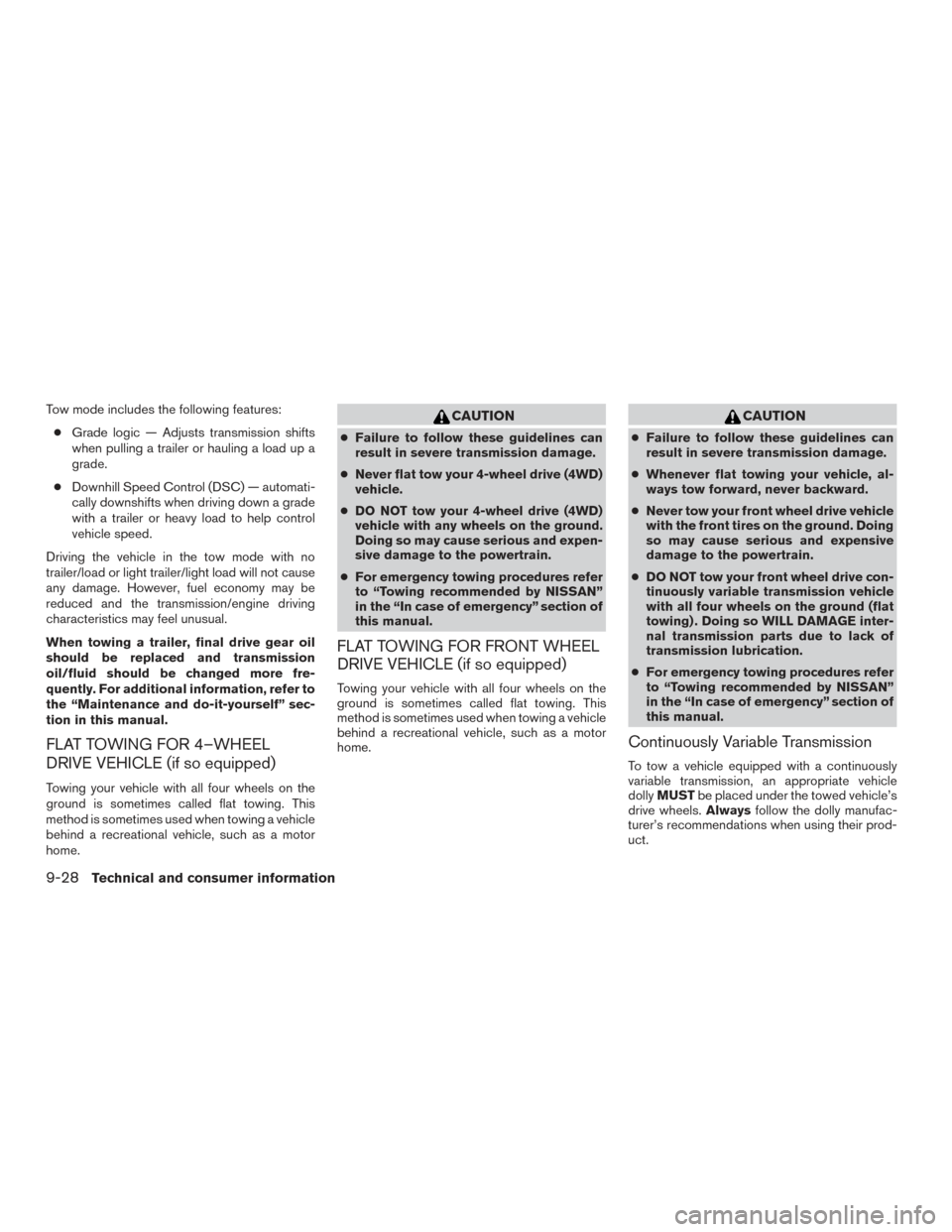
Tow mode includes the following features:● Grade logic — Adjusts transmission shifts
when pulling a trailer or hauling a load up a
grade.
● Downhill Speed Control (DSC) — automati-
cally downshifts when driving down a grade
with a trailer or heavy load to help control
vehicle speed.
Driving the vehicle in the tow mode with no
trailer/load or light trailer/light load will not cause
any damage. However, fuel economy may be
reduced and the transmission/engine driving
characteristics may feel unusual.
When towing a trailer, final drive gear oil
should be replaced and transmission
oil/fluid should be changed more fre-
quently. For additional information, refer to
the “Maintenance and do-it-yourself” sec-
tion in this manual.
FLAT TOWING FOR 4–WHEEL
DRIVE VEHICLE (if so equipped)
Towing your vehicle with all four wheels on the
ground is sometimes called flat towing. This
method is sometimes used when towing a vehicle
behind a recreational vehicle, such as a motor
home.
CAUTION
● Failure to follow these guidelines can
result in severe transmission damage.
● Never flat tow your 4-wheel drive (4WD)
vehicle.
● DO NOT tow your 4-wheel drive (4WD)
vehicle with any wheels on the ground.
Doing so may cause serious and expen-
sive damage to the powertrain.
● For emergency towing procedures refer
to “Towing recommended by NISSAN”
in the “In case of emergency” section of
this manual.
FLAT TOWING FOR FRONT WHEEL
DRIVE VEHICLE (if so equipped)
Towing your vehicle with all four wheels on the
ground is sometimes called flat towing. This
method is sometimes used when towing a vehicle
behind a recreational vehicle, such as a motor
home.
CAUTION
● Failure to follow these guidelines can
result in severe transmission damage.
● Whenever flat towing your vehicle, al-
ways tow forward, never backward.
● Never tow your front wheel drive vehicle
with the front tires on the ground. Doing
so may cause serious and expensive
damage to the powertrain.
● DO NOT tow your front wheel drive con-
tinuously variable transmission vehicle
with all four wheels on the ground (flat
towing) . Doing so WILL DAMAGE inter-
nal transmission parts due to lack of
transmission lubrication.
● For emergency towing procedures refer
to “Towing recommended by NISSAN”
in the “In case of emergency” section of
this manual.
Continuously Variable Transmission
To tow a vehicle equipped with a continuously
variable transmission, an appropriate vehicle
dolly MUST be placed under the towed vehicle’s
drive wheels. Alwaysfollow the dolly manufac-
turer’s recommendations when using their prod-
uct.
9-28Technical and consumer information
Page 517 of 540
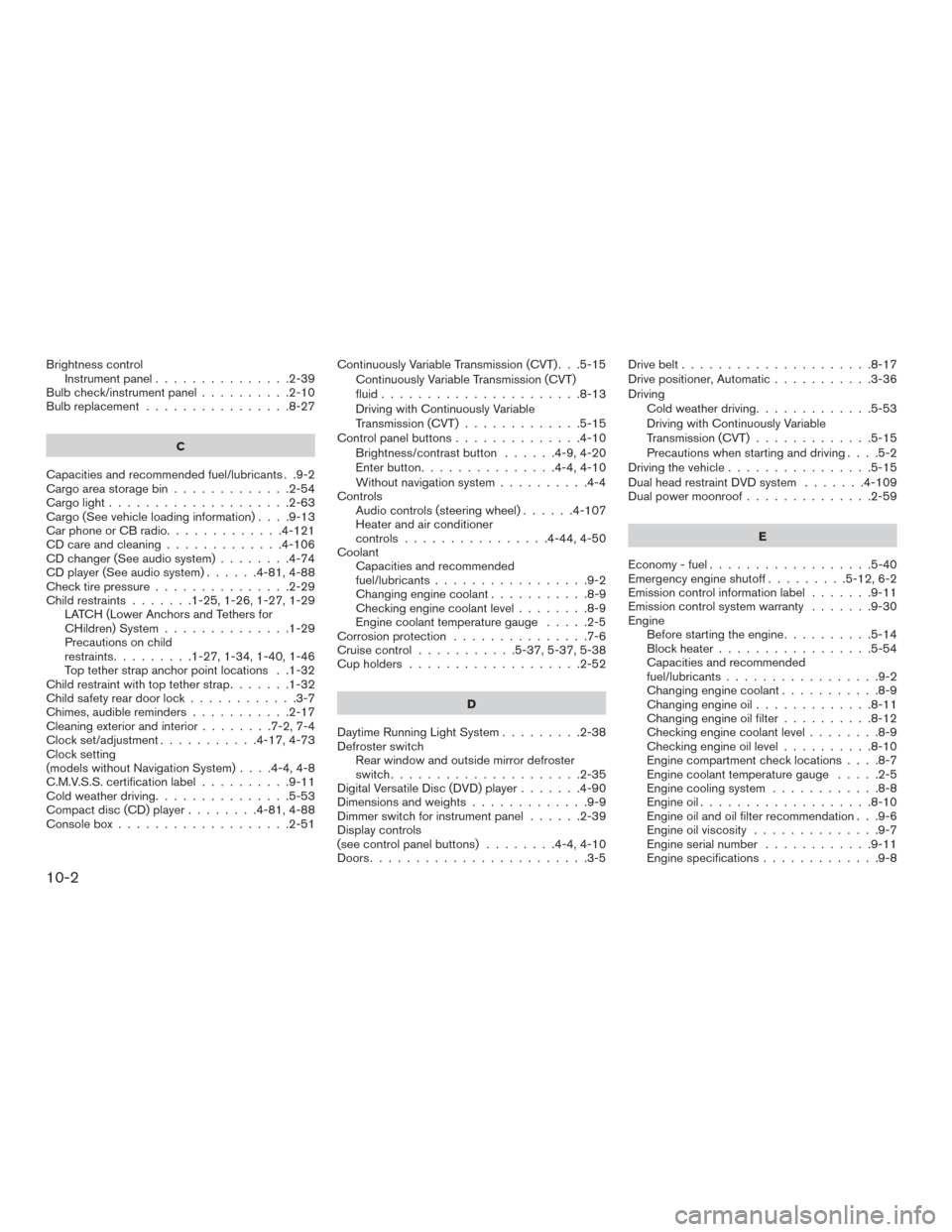
Brightness controlInstrument panel ...............2-39
Bulb check/instrument panel ..........2-10
Bulb replacement ................8-27
C
Capacities and recommended fuel/lubricants . .9-2
Cargoareastoragebin.............2-54
Cargolight....................2-63
Cargo(Seevehicleloadinginformation)....9-13
Car phone or CB radio .............4-121
CD care and cleaning .............4-106
CD changer (See audio system) ........4-74
CD player (See audio system) ......4-81,4-88
Check tire pressure ...............2-29
Child restraints .......1-25,1-26,1-27,1-29
LATCH (Lower Anchors and Tethers for
CHildren) System ..............1-29
Precautions on child
restraints.........1-27,1-34,1-40,1-46
Top tether strap anchor point locations . .1-32
Child restraint with top tether strap .......1-32
Child safety rear door lock ............3-7
Chimes, audible reminders ...........2-17
Cleaningexteriorandinterior........7-2,7-4
Clock set/adjustment ...........4-17,4-73
Clock setting
(models without Navigation System) ....4-4,4-8
C.M.V.S.S. certification label ..........9-11
Cold weather driving ...............5-53
Compact disc (CD) player ........4-81,4-88
Consolebox...................2-51 Continuously Variable Transmission (CVT) . . .5-15
Continuously Variable Transmission (CVT)
fluid......................8-13
Driving with Continuously Variable
Transmission (CVT) .............5-15
Control panel buttons ..............4-10
Brightness/contrast button ......4-9,4-20
Enterbutton...............4-4,4-10
Without navigation system ..........4-4
Controls Audio controls (steering wheel) ......4-107
Heater and air conditioner
controls................4-44,4-50
Coolant Capacities and recommended
fuel/lubricants .................9-2
Changingenginecoolant...........8-9
Checking engine coolant level ........8-9
Engine coolant temperature gauge .....2-5
Corrosion protection ...............7-6
Cruisecontrol ...........5-37,5-37,5-38
Cupholders...................2-52
D
Daytime Running Light System .........2-38
Defroster switch Rear window and outside mirror defroster
switch.....................2-35
Digital Versatile Disc (DVD) player .......4-90
Dimensionsandweights.............9-9
Dimmer switch for instrument panel ......2-39
Display controls
(seecontrolpanelbuttons) ........4-4,4-10
Doors ........................3-5 Drive belt
.....................8-17
Drive positioner, Automatic ...........3-36
Driving Cold weather driving .............5-53
Driving with Continuously Variable
Transmission (CVT) .............5-15
Precautions when starting and driving ....5-2
Driving the vehicle ................5-15
Dual head restraint DVD system .......4-109
Dual power moonroof ..............2-59
E
Economy-fuel..................5-40
Emergency engine shutoff .........5-12,6-2
Emission control information label .......9-11
Emission control system warranty .......9-30
Engine Before starting the engine ..........
5-14
Blockheater.................5-54
Capacities and recommended
fuel/lubricants.................9-2
Changing engine coolant ...........8-9
Changingengineoil.............8-11
Changing engine oil filter ..........8-12
Checking engine coolant level ........8-9
Checking engine oil level ..........8-10
Engine compartment check locations ....8-7
Engine coolant temperature gauge .....2-5
Engine cooling system ............8-8
Engineoil...................8-10
Engine oil and oil filter recommendation . . .9-6
Engine oil viscosity ..............9-7
Engine serial number ............9-11
Engine specifications .............9-8
10-2
Page 518 of 540
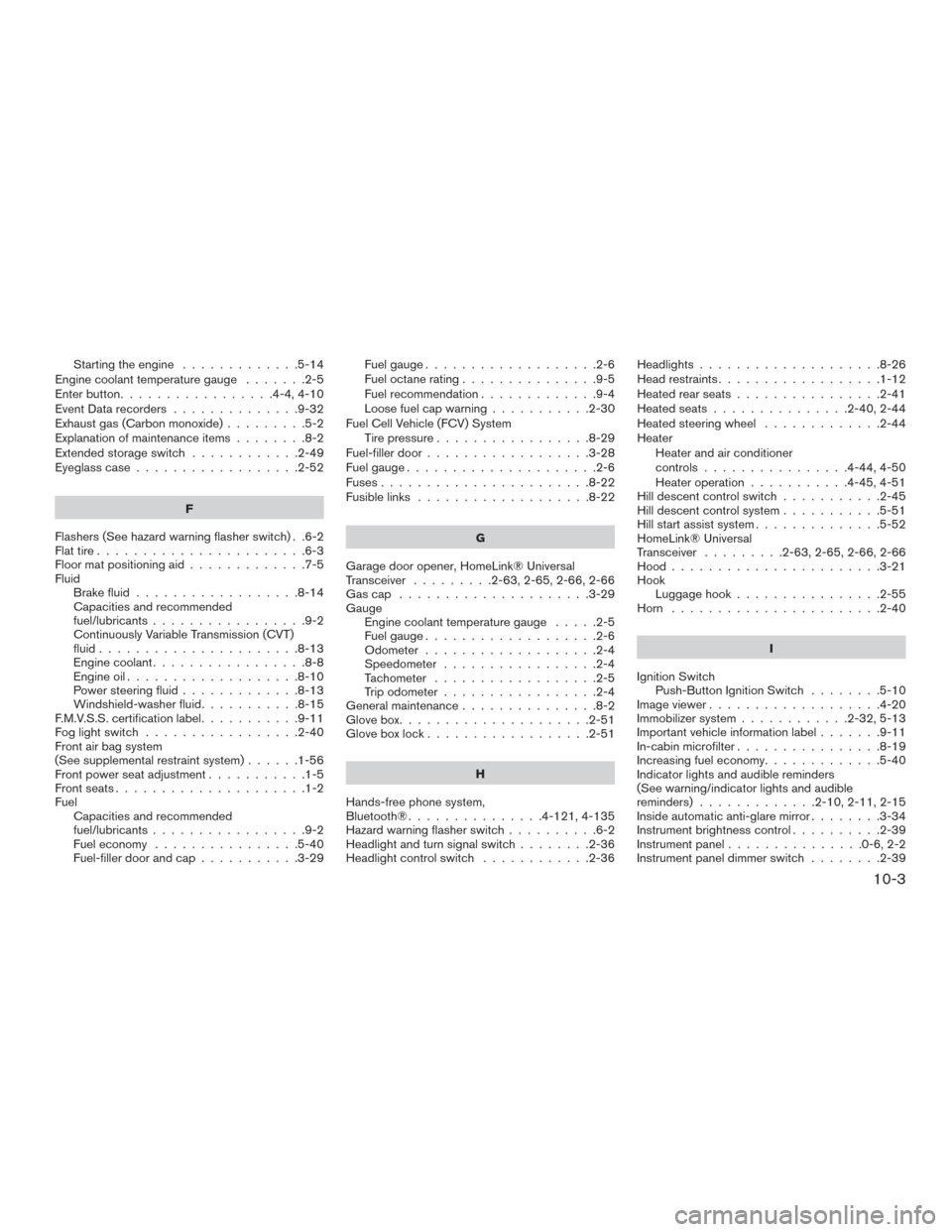
Starting the engine.............5-14
Engine coolant temperature gauge .......2-5
Enterbutton.................4-4,4-10
Event Data recorders ..............9-32
Exhaust gas (Carbon monoxide) .........5-2
Explanation of maintenance items ........8-2
Extendedstorageswitch ............2-49
Eyeglass case ..................2-52
F
Flashers (See hazard warning flasher switch) . .6-2
Flat tire .......................6-3
Floor mat positioning aid .............7-5
Fluid Brake fluid ..................8-14
Capacities and recommended
fuel/lubricants .................9-2
Continuously Variable Transmission (CVT)
fluid......................8-13
Engine coolant .................8-8
Engine oil ...................8-10
Power steering fluid .............8-13
Windshield-washerfluid...........8-15
F.M.V.S.S. certification label ...........9-11
Foglightswitch .................2-40
Front air bag system
(See supplemental restraint system) ......1-56
Front power seat adjustment ...........1-5
Frontseats.....................1-2
Fuel Capacities and recommended
fuel/lubricants .................9-2
Fuel economy ................5-40
Fuel-filler door and cap ...........3-29 Fuel gauge
...................2-6
Fuel octane rating ...............9-5
Fuel recommendation .............9-4
Loose fuel cap warning ...........2-30
Fuel Cell Vehicle (FCV) System Tirepressure.................8-29
Fuel-filler door ..................3-28
Fuelgauge.....................2-6
Fuses.......................8-22
Fusiblelinks ...................8-22
G
Garage door opener, HomeLink® Universal
Transceiver .........2-63,2-65,2-66,2-66
Gascap .....................3-29
Gauge Engine coolant temperature gauge .....2-5
Fuel gauge ...................2-6
Odometer ...................2-4
Speedometer .................2-4
Tachometer ..................2-5
Trip odometer .................2-4
General maintenance ...............8-2
Glovebox.....................2-51
Gloveboxlock..................2-51
H
Hands-free phone system,
Bluetooth®...............4- 121, 4-135
Hazard warning flasher switch ..........6-2
Headlight and turn signal switch ........2-36
Headlight control switch ............2-36 Headlights....................8-26
Head restraints
..................1-12
Heated rear seats ................2-41
Heated seats ...............2-40,2-44
Heated steering wheel .............2-44
Heater Heater and air conditioner
controls ................4-44,4-50
Heater operation ...........4-45,4-51
Hill descent control switch ...........2-45
Hill
descent control system ...........5-51
Hill start assist system ..............5-52
HomeLink® Universal
Transceiver .........2-63,2-65,2-66,2-66
Hood.......................3-21
Hook Luggage hook ................2-55
Horn .......................2-40
I
Ignition Switch Push-Button Ignition Switch ........5-10
Imageviewer...................4-20
Immobilizer system ............2-32,5-13
Important vehicle information label .......9-11
In-cabin microfilter ................8-19
Increasing fuel economy .............5-40
Indicator lights and audible reminders
(See warning/indicator lights and audible
reminders).............2-10,2-11,2-15
Inside automatic anti-glare mirror ........3-34
Instrument brightness control ..........2-39
Instrumentpanel...............0-6,2-2
Instrument panel dimmer switch ........2-39
10-3
Page 519 of 540
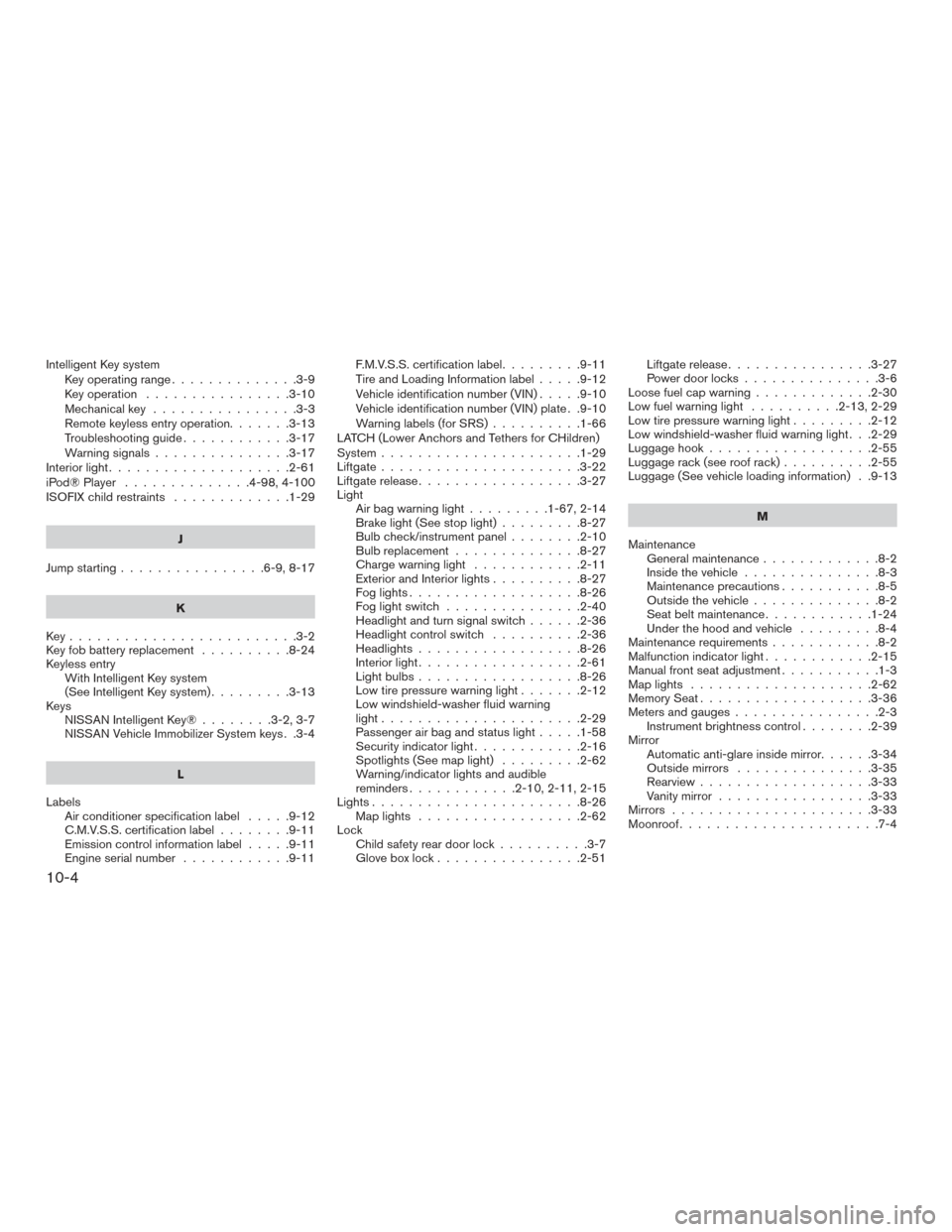
Intelligent Key systemKey operating range ..............3-9
Key operation ................3-10
Mechanicalkey ................3-3
Remote keyless entry operation.......3-13
Troubleshooting guide ............3-17
Warning signals ...............3-17
Interiorlight....................2-61
iPod®Player ..............4-98,4-100
ISOFIX child restraints .............1-29
J
Jump starting ................6-9,8-17
K
Key.........................3-2
Key fob battery replacement ..........8-24
Keyless entry With Intelligent Key system
(See Intelligent Key system) .........3-13
Keys NISSAN Intelligent Key® ........3-2,3-7
NISSAN Vehicle Immobilizer System keys . .3-4
L
Labels Air conditioner specification label .....9-12
C.M.V.S.S. certification label ........9-11
Emissioncontrolinformationlabel.....9-11
Engine serial number ............9-11 F.M.V.S.S. certification label
.........9-11
Tire and Loading Information label .....9-12
Vehicle identification number (VIN) .....9-10
Vehicle identification number (VIN) plate . .9-10
Warning labels (for SRS) ..........1-66
LATCH (Lower Anchors and Tethers for CHildren)
System ......................1-29
Liftgate ......................3-22
Liftgate release ..................3-27
Light Air bag warning light .........1-67,2-14
Brake light (See stop light) .........8-27
Bulb check/instrument panel ........2-10
Bulbreplacement..............8-27
Charge warning light ............2-11
Exterior and Interior lights ..........8-27
Foglights...................8-26
Foglightswitch ...............2-40
Headlight and turn signal switch ......2-36
Headlight control switch ..........2-36
Headlights..................8-26
Interiorlight..................2-61
Lightbulbs..................8-26
Low tire pressure warning light .......2-12
Low windshield-washer fluid warning
light......................2-29
Passenger air bag and status light .....1-58
Security indicator light ............2-16
Spotlights(Seemaplight) .........2-62
Warning/indicator lights and audible
reminders ............2-10,2-11,2-15
Lights.......................8-26 Maplights ..................2-62
Lock Child safety rear door lock ..........3-7
Gloveboxlock................2-51 Liftgate release
................3-27
Power door locks ...............3-6
Loose fuel cap warning .............2-30
Low fuel warning light ..........2-13,2-29
Low tire pressure warning light .........2-12
Low windshield-washer fluid warning light . . .2-29
Luggage hook ..................2-55
Luggage rack (see roof rack) ..........2-55
Luggage (See vehicle loading information) . .9-13
M
Maintenance General maintenance .............8-2
Insidethevehicle...............8-3
Maintenance precautions ...........8-5
Outside the vehicle ..............8-2
Seat
belt maintenance ............1-24
Under the hood and vehicle .........8-4
Maintenance requirements ............8-2
Malfunction indicator light ............2-15
Manual front seat adjustment ...........1-3
Maplights ....................2-62
Memory Seat ...................3-36
Meters and gauges ................2-3
Instrument brightness control ........2-39
Mirror Automatic anti-glare inside mirror ......3-34
Outside mirrors ...............3-35
Rearview ...................3-33
Vanity mirror .................3-33
Mirrors ......................3-33
Moonroof ......................7-4
10-4